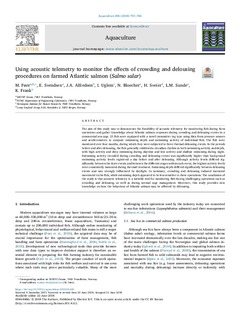| dc.contributor.author | Føre, Martin | |
| dc.contributor.author | Svendsen, Eirik | |
| dc.contributor.author | Alfredsen, Jo Arve | |
| dc.contributor.author | Uglem, Ingebrigt | |
| dc.contributor.author | Bloecher, Nina | |
| dc.contributor.author | Sveier, Harald | |
| dc.contributor.author | Sunde, Leif Magne | |
| dc.contributor.author | Frank, Kevin | |
| dc.date.accessioned | 2018-08-05T14:31:14Z | |
| dc.date.available | 2018-08-05T14:31:14Z | |
| dc.date.created | 2018-08-03T15:52:21Z | |
| dc.date.issued | 2018-10-01 | |
| dc.identifier.citation | Aquaculture. 2018, 495 757-765. | nb_NO |
| dc.identifier.issn | 0044-8486 | |
| dc.identifier.uri | http://hdl.handle.net/11250/2507450 | |
| dc.description.abstract | The aim of this study was to demonstrate the feasibility of acoustic telemetry for monitoring fish during farm operations and gather knowledge about Atlantic salmon responses during crowding and delousing events in a commercial sea-cage. 21 fish were equipped with a novel transmitter tag type using data from pressure sensors and accelerometers to compute swimming depth and swimming activity of individual fish. The fish were monitored over four months, during which they were subjected to three thermal delousing events. In the periods before and after delousing, the fish generally exhibited a circadian rhythm in both swimming activity and depth, with high activity and deep swimming during daytime and low activity and shallow swimming during night. Swimming activity recorded during crowding and delousing events was significantly higher than background swimming activity levels registered a day before and after delousing. Although activity levels differed significantly between the three events and between the different stages within each event, the highest activity levels were consistently measured during thermal treatment. Swimming depth differed significantly between delousing events and was strongly influenced by daylight. In summary, crowding and delousing induced increased movement in the fish, while swimming depth appeared to be less sensitive to these operations. The conclusion of the study is that acoustic telemetry is a suitable tool for monitoring fish during challenging operations such as crowding and delousing, as well as during normal cage management. Moreover, this study provides new knowledge on how the behaviour of Atlantic salmon may be affected by delousing. | nb_NO |
| dc.language.iso | eng | nb_NO |
| dc.publisher | Elsevier | nb_NO |
| dc.rights | Navngivelse 4.0 Internasjonal | * |
| dc.rights.uri | http://creativecommons.org/licenses/by/4.0/deed.no | * |
| dc.title | Using acoustic telemetry to monitor the effects of crowding and delousing procedures on farmed Atlantic salmon (Salmo salar) | nb_NO |
| dc.title.alternative | Using acoustic telemetry to monitor the effects of crowding and delousing procedures on farmed Atlantic salmon (Salmo salar) | nb_NO |
| dc.type | Journal article | nb_NO |
| dc.type | Peer reviewed | nb_NO |
| dc.description.version | publishedVersion | nb_NO |
| dc.rights.holder | © 2018 The Authors. Published by Elsevier B.V. | nb_NO |
| dc.source.pagenumber | 757-765 | nb_NO |
| dc.source.volume | 495 | nb_NO |
| dc.source.journal | Aquaculture | nb_NO |
| dc.identifier.doi | 10.1016/j.aquaculture.2018.06.060 | |
| dc.identifier.cristin | 1599702 | |
| cristin.unitcode | 7566,2,0,0 | |
| cristin.unitname | Sjømatteknologi | |
| cristin.ispublished | true | |
| cristin.fulltext | original | |
| cristin.qualitycode | 1 | |

